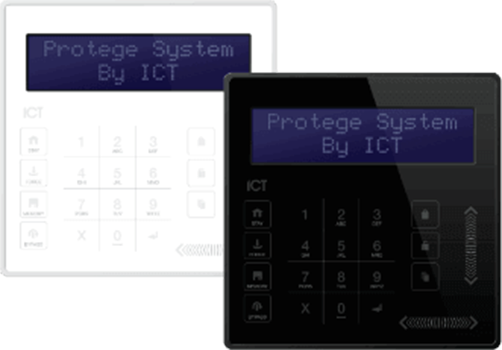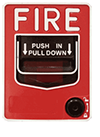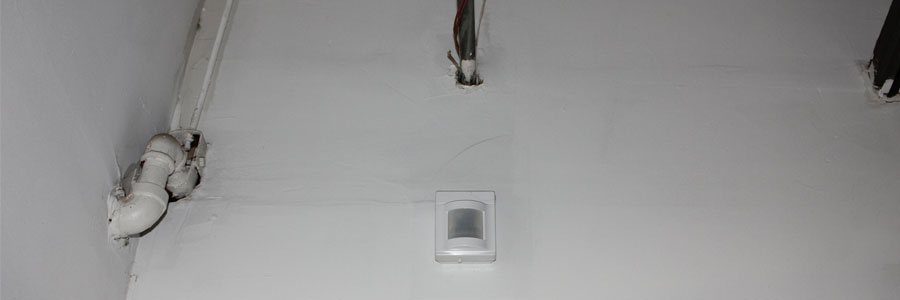Video MGMT System
 Access Control
Access Control
Voice & Data Wiring
 Burglar Alarm
Burglar Alarm
 Fire Alarm
Fire Alarm
Video MGMT System
Voice & Data Wiring
Businesses of all sizes are increasingly able to afford high-tech burglar alarm systems to monitor their properties and ensure an adequate response in the event of a break-in.
But with many burglar alarm brands on the market, choosing the right one to meet your security needs can be a challenge. That's why our team at Mammoth Security has put together this guide to help you learn more about some of the best commercial burglar alarm systems available today.
The basic components of a burglar alarm system are sensors to detect intrusion, keypads and other interfaces for system management, and a control panel where sensor data is transmitted and assessed.
Burglar alarm sensors include window contacts, glass-break sensors, and movement detectors. They are installed on doors, windows, and other areas where intrusion may be detected.
When an alarm system is armed, sensors actively monitor designated areas for signs of intrusion. If a sensor is triggered, the system's control panel will indicate that there has been a breach.
A triggered alarm may send a notification to the system's user, to a professional monitoring service, or even to law enforcement. And some alarm system packages include devices like sirens and strobe lights to deter intruders.
Most of today's alarm systems can be controlled using a smartphone app or web browser. This lets customers remotely arm and disarm their system, check their system's status, and receive timely alerts and notifications on any device with an Internet connection.
Commercial burglar alarm systems are designed by unique research and engineering teams for individual security system manufacturers. When narrowing down the best business burglar alarm to secure your property, consider factors like the equipment included with the alarm package, the remote monitoring services offered by the manufacturer, opportunities for customization, and the ability to integrate with other security systems.

Different burglar alarm packages come with different sets of sensors and detectors—so it's necessary to carefully consider your security needs before investing in any particular package.
Also, consider the design of keypads for activating and deactivating alarms. Keypads come in different sizes, and some are easier to read and use than others.
Alarm systems can be hardwired or wireless. The best home security systems are mostly wireless, but the professional installation of a hardwired alarm system is recommended for commercial properties.
Some burglar alarms also include backup battery power to ensure that the system remains operational during power outages.
The alarm system you have installed should be able to integrate with other security systems, such as access control, CCTV, and fire alarms.
Some alarm system packages even include wireless remote controllers for easy management of smart building automations.
Many but not all business burglar alarm packages include options for 24/7 remote professional monitoring. Professional monitoring is a wise investment for properties with valuable assets that aren't protected around the clock by on-site personnel.
Burglar alarm systems for businesses require professional hardwiring for reliability. Reaching out to professional security installers early in the alarm selection process will ensure that your investment is compatible with your existing infrastructure and will meet the security needs of your facility.
A security review or audit from professional security system experts, like those at Mammoth Security, will identify vulnerabilities in your current system and provide insights to enhance the overall security of your facility—whether that be small adjustments to your current alarm system, the addition of compatible devices for extended coverage and functionalities, or a new system entirely.

With the DMP Virtual Keypad app, customers can manage alarms, DMP access control, and sometimes their entire security camera installation on one intuitive interface.
ICT Class 5 systems use the latest rolling key encryption standards to provide customers with maximum security.
The Total Connect 2.0 add-on lets users manage security devices, receive alerts, and control home amenities remotely through a smartphone app or computer.
Napco alarm systems use highly reliable security sensors that have been perfected over decades of research and engineering.
Even when disarmed, customers can type a duress code into their keypad to activate an alarm and sirens. Each 2GIG keypad includes Panic, Fire, and Emergency buttons.
Category 1 refers to a low-priority alarm. These alarms are rarely critical and do not require immediate attention. An automatic chime or another sound when a customer enters a small business is an example of a category 1 alarm.
Category 2 refers to a medium-priority alarm, such as a smoke or heat detector. These alarms indicate a possible fire or other hazard and require prompt attention.
Category 3 refers to a high-priority alarm, such as an alarm sensing a gas leak. These alarms indicate potential life-and-death emergencies and require immediate attention.
Category 4 refers to critical alarms like panic buttons at banks. These alarms are typically used in sensitive areas and require an immediate response.
Category 5 refers to an emergency alarm, such as a fire alarm. These alarms require immediate evacuation and emergency response.
The most common types of alarm systems on commercial properties are burglar alarms and fire alarms. Burglar alarms detect unauthorized entries and often feature motion sensors, door and window contacts, and glass break detectors. Fire alarms detect smoke, heat, and other signs of fire. They often feature smoke and heat detectors, manual pull stations, and sprinkler systems.
The 7 main types of alarms include alarm systems and alarm components. The main alarm systems are fire alarms, heat alarms, and burglar alarms. And the main alarm components are motion sensors, contact sensors, door sensors, and infrared sensors.
Grade 1, 2, 3, and 4 alarms are categories established by the National Fire Protection Association (NFPA) to represent different levels of alarm system reliability and performance. Grade 1 alarms are the most reliable. They're ideal for critical applications where maximum protection is required. Grade 2 and grade 3 alarms provide moderate protection. And grade 4 alarms are the least reliable. They're intended for applications where the risk of loss or damage is insignificant.

Thanks for reading about burglar alarms for businesses on our website. We want you to know that you can trust our team at Mammoth Security to develop and install the right security solutions to protect your commercial property. From alarms and access control to cameras and cabling, we take pride in what we do, and we’d love to share our expertise and workmanship with you.
If you're ready for the next step toward securing your property, just fill out the simple form below to set up a free, zero-obligation site consultation. You’ll meet a friendly member of our team as we survey your property, discuss your security concerns, spot points where your security can be improved, and begin to develop a security system that’s expertly tailored to your site’s unique layout and needs.

Wireless
IP Cameras
Wireless cameras are not reliable enough for commercial use yet. Instead, we use purpose-built antennae to connect hardwired cameras on light poles and buildings.

Phone App
For Camera Systems
Watch live or previously recorded footage on any mobile device. Save it to your phone and e-mail it just like any other video or image.

Increased Resolution
Of 4096×2160
4k or 8MP cameras represent the best value at the moment. Depending on your situation, a 30+ megapixel camera can be installed allowing you to read a seat number from the opposite end of a football field.

Employ The Same Technology As These Companies:


